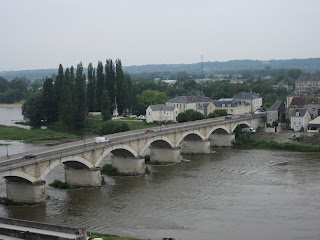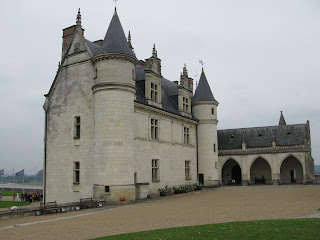Karl leaning against a half-timbered home. It WAS a windy day!
To begin our touring day, lunch next to the château.

This picturesque town, in its delightful setting on the banks of the Loire, is distinguished by its majesty and the live feeling of history.
Few buildings are more historically important than the Château d'Amboise. Louis XI lived here; Charles VIII was born and died here; François I was brought up here, as were Catherine de' Medici's 10 children. Leonardo Da Vinci worked here for the last three years of his life.
Notice the sharp precipice on the right. That's how you get in...

View from another angle.
It's a LONG climb to even get to the entrance (about 4 stories' worth). The château has 3 levels.
Karl climbs faster than me.
Once you've arrived on the upper grounds of the château, on the ramparts, you notice the beautifully restored Gothic Chapelle St-Hubert, Leonardo da Vinci's burial place.
 I thought the sculpture on the face of the building was incredible and have given you a progressive close-up so that you can better appreciate it.
I thought the sculpture on the face of the building was incredible and have given you a progressive close-up so that you can better appreciate it.
The gargoyles were so ferocious looking...
Leonardo Da Vinci was 67 when he died, a very old man for the times.
The chapel is surprisingly small.
This is the gate Leonardo used to enter the château. Under the patronage of François I, the artist lived in the nearby manor house of Clos-Lucé, walking distance away.

Bust of Leonardo Da Vinci
The grounds of the Château d'Amboise are very unusual, as evidenced by these sculpted gardens.
The inside of the Château is well furnished, including some spectacular tapestries.
Knights' armour for Karl to admire.


The guards' room controlled the upper level where the king resided.
This is the Hall of the States.
Royal bedrooms. This one belonged to Henri II.
One of the first sleigh beds. Louis-Philippe's room.

The Cupbearer's Room recalls changes in table manners at court. This room is where the cupbearer served drinks. Medieval trestle tables were being replaced by fixed tables. Italian-style tables then became fashionable, richly decorated and with extensions. Despite the timid introduction of the two-pronged fork, the knife and spoon remained more popular up to the reign of Henri III.
The Music Room
A grand piano (Erard) with veneer in rosewood from Rio. (XIX century)
A carved box - a masterpiece.

If you enlarge this photo, you will notice the complex locks.
The Franciscan Antechamber (L'antichambre de la cordelière)
The interwoven cord found on this chimney is the symbol for the Franciscan Order.
The Tour de Minimes, the château's original entrance, is famous for its huge spiral ramp up which horsemen could ride to deliver provisions.

The guards' walk is right next to the metal lacework balcony which served as a gibbet for 12 of the 1200 conspirators who were put to death. This refers to the 1560 Amboise Conspiracy, an ill-fated Huguenot plot against François II.


View of Amboise from the guards' walk.
The centre building in this photo, the one with the white awnings, is Maison Bigot, Chocolatier. We stopped in for afternoon tea.
The original owners, 1913. It was like dropping in on old friends.
Loved the ambiance, so charming.

































No comments:
Post a Comment